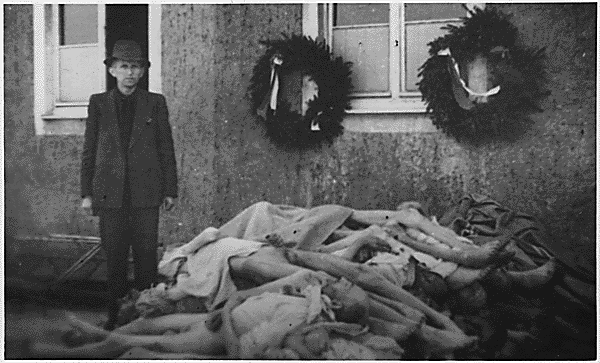Buchenwald Concentration Camp at Christmas Time
Historian Ian Kershaw has convincingly pointed to the winter of 1940-41 as when the "Final Solution" to the "Jewish problem", as Hitler and his ideological accomplices labeled the "issue" presented by Jews in German occupied territories, took a quantum leap toward reality. The "first solution" to the "Jewish problem" had involved Nazi authorities expelling Jews from small towns and villages across Germany, with the Jews either leaving Germany, or collecting in larger cities. The "second solution" featured forced emigration resulting in 250,000 of 1938 Germany's 500,000 Jews having left Germany by the time the War began - including 100,000 Jews that went to the US, 63,000 to Argentina, 52,000 to Britain, and 33,000 to Palestine. Unfortunately, many countries began tightening immigration laws in response, and many Jews fled to countries that would soon be overrun by the Third Reich once war began. In addition, once Germany began to conquer much of Europe millions more Jews had come under German control.
Although there has not yet been found a specific order for mass murder as a "final solution", according to Kershaw, during the dark winter months Hitler ordered Heydrich to prepare for a third solution; the "'final evacuation' of the German Jews to the Central Government". On January 21, Theodor Dannecker, associate to Eichmann wrote "In accordance with the will of the Fuhrer, the Jewish question within the part of Europe ruled or controlled by Germany is after the war to be subjected to a final solution (einer endgultigen Losung)." Heydrich and Eichmann began work on a "project" estimated to involve approximately 5.8 million people.
Heydrich and Himmler's work soon went beyond the "Jewish question". On June 21, 1941, Himmler ordered planning to begin for a massive demographic reorganization of Eastern Europe, including the territories of the western Soviet Union. Professor Konrad Meyer authored the subsequent plan labeled Generalplan Ost. Meyer's genocidal plan went far beyond eliminating Europe's Jews. Meyer's plan, approved by Himmler and Heydrich, foresaw removing at least 31 million people from Poland, Belorussia, the Ukraine, and the Baltic States. Generalplan Ost
established the horrifying scope to the planned annihilation of Eastern Europe's people; especially Eastern Europe's Jewish and Slavic people.
The Generalplan Ost predated the latter and infamous Wansee Conference, outlining the Jewish Holocaust, by over six months, and the increasingly common use of the term "final solution" - by men such as Eichmann - predated Wansee by at least three months with "final solution" regularly showing up in correspondence from Eichmann and other government officials from October 1941 forward.
The Generalplan Ost represented more than just sheer genocidal destruction. The plan also envisioned a massive outlay of capital to build infrastructure, industry, cities, and agriculture in the eastern territories. Himmler planned on spending the enormous sum of 67 billion Reichsmarks, or more money than Germany invested in rearmament from 1930-1939. According to Himmler, in the summer of 1942 at a top level SS meeting, the labor necessary for this massive construction plan would be slave labor. Himmler, seeking to cast his arguments with a positive economic spin, argued slave labor would help lower costs by as much as 40 percent. Himmler's slaves would be organized into work camps, worked to the death, and comprising hundreds of thousands of people selected from the occupied lands based upon their work capabilities. As a result the German camp system would feature a two-tiered approach with "death camps" and "work camps", although some death camps (such as Auschwitz) maintained a dual role of both "death" and "work" camp. For the most part the Jew was destined for elimination, often right off the bat, with the Slav scheduled to be the primary slave laborer for building the National Socialist Empire.
Courtesy US National Archives, ARC identifier no. 195357


